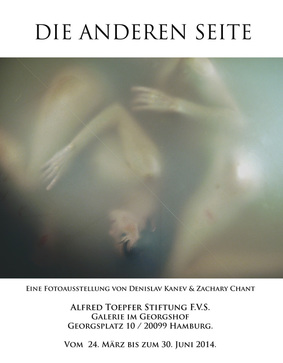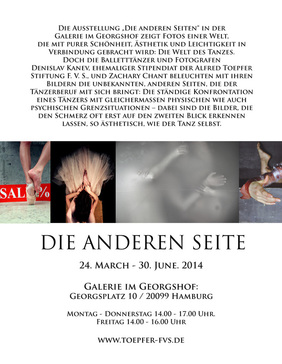|
Denislav Kanev and Zachary Chant will present a photographic exhibition in the Galerie im Georgshof in Hamburg entitled 'Die Anderen Seite - Bilder aus der Welt des Tanzes" ("The Other SIde" - Images From the World of Dance).
This collection of photographic images depict some of the lesser known aspects of what it means to be a dancer. Thanks to the generous assistance of the Alfred Toepfer Stiftung F.V.S the collection can be viewed until the 30th of June. Further information including opening hours can be found directly at the gallery's website. |
English Deutsch
|
THE OTHER SIDE - Images from the world of dance
The exhibition " The Other Side " in the Georgshof gallery displays a world that is associated with pure beauty, aesthetics and ease: the world of dance. The ballet dancers and photographers Denislav Kanev, a former fellow of the Alfred Toepfer Foundation F.V.S, and Zachary Chant illuminate the unknown sides of the dancers’ job with their images: The constant confrontation of a dancer with both physical and mental limitations. While the audience of a ballet performance only gets to see the beautiful side of the dance, dancers themselves are often afflicted with physical problems, pain, and physical overstraining. Muscles and joints become pushed to the limits of their endurance – often resulting in stretched ligaments and trauma to the joints. The fear of getting hurt and not being able to dance, is a constant companion to every dancer - because the dance market is big, young dancers are just waiting to snag one of the few vacant positions. A dancer has to constantly demand everything from themselves and their body in order to survive in the professional world. This physical and mental stress also comes from working and living in a country that is not your own, where one feels removed, and as a stranger. How many dancers find their commitment drawing them away from their family and friends to another country or continent, just to realise their dream to dance. A dancer’s company often serves as a kind of multicultural "surrogate family". Yet it is often not a simple constellation, as a friend and colleague can also be one of the fiercest competitors in the daily battle to be the best. The price for the "beautiful illusion" of what the ballet audience can admire on stage every night is high. In the formative years of their career, the physical and emotional sacrifices that a ballet dancer brings to their craft, often forces them to seek a different career. One that is not so stressful, strenuous and demanding on the spirit and body. And yet still it remains, the urge to dance… The love of movement is as old as humanity itself - and a dancer can not help but dance. The photo exhibition "The Other Side" shows the dark side that may accompany the profession of a ballet dancer - here are the images that can often recognise the pain only at a second glance, as aesthetically pleasing as the dance itself. |
DIE ANDEREN SEITEN – Bilder aus der Welt des Tanzes
Die Ausstellung „Die anderen Seiten“ in der Galerie im Georgshof zeigt Fotos einer Welt, die mit purer Schönheit, Ästhetik und Leichtigkeit in Verbindung gebracht wird: Die Welt des Tanzes. Doch die Balletttänzer und Fotografen Denislav Kanev, ehemaliger Stipendiat der Alfred Toepfer Stiftung F. V. S., und Zachary Chant beleuchten mit ihren Bildern die unbekannten, anderen Seiten, die der Tänzerberuf mit sich bringt: Die ständige Konfrontation eines Tänzers mit gleichermaßen physischen wie auch psychischen Grenzsituationen. Während das Publikum einer Ballettvorstellung nur die schönen Seiten des Tanzes zu sehen bekommt, quälen sich Tänzer häufig mit körperlichen Problemen, Schmerzen und physischer Überanspruchung. Muskeln und Gelenke werden bis an die Grenzen ihrer Belastbarkeit gereizt – Bänderdehnungen und Gelenktraumata sind nicht selten die Folge. Die Angst, sich zu verletzen und nicht mehr tanzen zu können, ist ein ständiger Begleiter eines jeden Tänzers – denn der Tanzmarkt ist groß, Nachwuchstänzer warten nur darauf, eine der wenigen vakanten Stellen zu ergattern. Ein Tänzer muss sich ständig beweisen, alles von sich und seinem Körper abverlangen, um im Berufsleben bestehen zu können. Zu dieser physischen wie auch psychischen Belastung kommt oftmals noch das Gefühl, in dem Land, in dem man arbeitet, ein Fremder zu sein: Wie viele der Tänzer finden ihr Engagement nur fern der Heimat auf einem anderen Kontinent, lassen Familie und Freunde zu Hause zurück, um ihren Traum vom Tanzen zu verwirklichen. Man versucht, sich in die Gesellschaft des jeweiligen Landes, in dem man Arbeit gefunden hat, einzufügen, zu integrieren, wobei die eigene Compagnie oft zu einer Art multikulturellen „Ersatzfamilie“ wird – eine oft nicht ganz einfache Konstellation, da der Freund und Kollege gleichzeitig auch zum einem der ärgsten Konkurrenten im täglichen Kampf, der Beste zu sein, werden kann. Der Preis für den „schönen Schein“, für das, was das Ballettpublikum allabendlich auf der Bühne bewundern darf, ist hoch: Die körperlichen und seelischen Opfer, die ein Balletttänzer bringt, zwingen ihn nicht selten genug dazu, in noch jungen Jahren das Metier zu wechseln und sich einen anderen Beruf zu suchen. Und dennoch gibt es ihn, den Drang, zu tanzen, seinem Körper alles abzuverlangen und auf der Bühne zu stehen. Die Lust an der Bewegung ist so alt wie die Menschheit selbst – und ein Tänzer kann nicht anders, als zu TANZEN. Die Fotoausstellung „Die anderen Seiten“ zeigt die Schattenseiten, die der Beruf eines Balletttänzers mit sich bringt – dabei sind die Bilder, die den Schmerz oft erst auf den zweiten Blick erkennen lassen, so ästhetisch, wie der Tanz selbst. |


